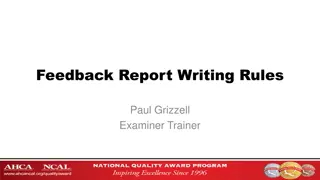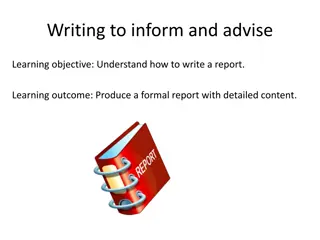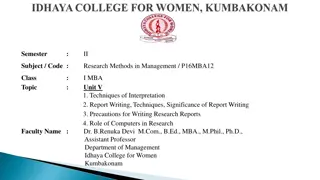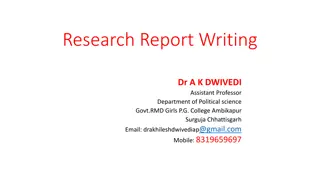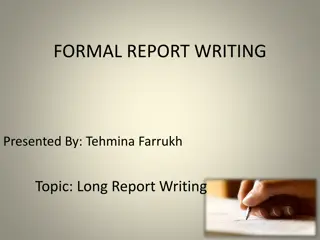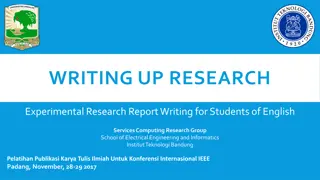Effective Steps in Writing a Research Report
Writing a research report involves several stages such as analyzing the subject matter, creating a research outline, preparing a rough draft, rewriting, and finalizing with a bibliography. Each step plays a crucial role in producing a well-structured and informative report that caters to the purpose and audience.
Download Presentation

Please find below an Image/Link to download the presentation.
The content on the website is provided AS IS for your information and personal use only. It may not be sold, licensed, or shared on other websites without obtaining consent from the author.If you encounter any issues during the download, it is possible that the publisher has removed the file from their server.
You are allowed to download the files provided on this website for personal or commercial use, subject to the condition that they are used lawfully. All files are the property of their respective owners.
The content on the website is provided AS IS for your information and personal use only. It may not be sold, licensed, or shared on other websites without obtaining consent from the author.
E N D
Presentation Transcript
Stages in Writing Research Report Report writing is a time consuming and expensive exercise. Therefore, reports have to be very sharply focused on purpose content and readership. There is no single universally acceptable method of writing a research report. Following are the general steps in writing a research report: Analysis of the subject matter Research outline Preparation of rough draft Rewriting and polishing Preparation of final Bibliography Writing the final draft
Analysis of the subject matter This is the first and important step in writing a research report. It is concerned with the development of a subject. Subject matter should be written in a clear, logical and concise manner. The style adopted should be open, straightforward and dignified and folk style language should be avoided. The data, the reliability and validity of the results of the statistical analysis should be in the form of tables, figures and equations. All redundancy in the data or results presented should be eliminated.
Research outline The research outline is an organisational framework prepared by the researcher well in advance. It is an aid to logical organisation of material and a reminder of the points to be stressed in the report. In the process of writing, if need be, outline may be revised accordingly. Time and place of the study, scope and limitations of the study, study design, summary of pilot study, methods of data collection, analysis interpretation, etc., may be included in a research outline.
Preparation of rough draft Having prepared the primary and secondary data, the researcher has to prepare a rough draft. While preparing the rough draft, the researcher should keep the objectives of the research in mind and focus on one objective at a time. The researcher should make a checklist of the important points that are necessary to be covered in the manuscript. A researcher should use dictionary and relevant reference materials as and when required.
Rewriting and polishing This is an important step in writing a research report. It takes more time than a rough draft. While rewriting and polishing, a researcher should check the report for weakness in logical development or presentation. He should take breaks in between rewriting and polishing since this gives the time to incubate the ideas.
Preparation of final Bibliography The bibliography, which is generally appended to the research report, is a list of books in some way pertinent to the research which has been done. It should contain all those works which the researcher has consulted. The bibliography should be arranged alphabetically and may be divided into 2 parts; The first part may contain the names of books and pamphlets. And the second part may contain the names of magazines and newspaper articles. Generally. This pattern of bibliography is considered convenient and satisfactory from the point of view of reader. though it is not the only way of presenting bibliography.
Writing the final draft The last and important step is writing the final draft. The language of the report should be simple, employing appropriate words and expressions and should avoid vague expressions such as it seems and there may be etc. It should not use personal pronouns, such as I, We, My, Us, etc. and should substitute these by such expressions as a researcher, investigator, etc. Before the final drafting of the report, it is advisable that the researcher should prepare a first draft for critical considerations and possible improvements. It will be helpful in writing the final draft. Finally, the report should be logically outlined with the future directions of the research based on the work completed.











